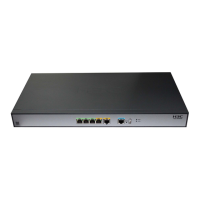26
Configuring data transmit rates
Configuring 802.11b/802.11g rates
Step Command Remarks
1. Enter system view.
system-view
N/A
2. Enter WLAN RRM view.
wlan rrm
N/A
3. Configure rates for 802.11b.
dot11b
{
disabled-rate
|
mandatory-rate
|
multicast-rate
|
supported-rate
} rate-value
Optional.
By default, no rates are disabled.
Mandatory rates are 1 and 2. The
multicast rate is automatically
selected from mandatory rates.
Supported rates are 5.5 and 11.
4. Configure rates for 802.11g.
dot11g
{
disabled-rate
|
mandatory-rate
|
multicast-rate
|
supported-rate
} rate-value
Optional.
By default, no rates are disabled.
Mandatory rates are 1, 2, 5.5, and
11. The multicast rate is
automatically selected from
mandatory rates. Supported rates
are 6, 9, 12, 18, 24, 36, 48, and
54.
Configuring 802.11n rates
The following matrix shows the feature and router compatibility:
Feature
MSR80
0
MSR
900
MSR90
0-E
MSR
930
MSR
20-1X
MSR 20 MSR 30 MSR 50
802.11n
Available
for
MSR800
-W and
MSR800
-10-W
No
Available
for
MSR900
-E-W
Available
for MSR
930-W,
MSR
930-W-G
U, and
MSR
930-W-G
T
Available
for
routers
with a
SIC_WL
AN
module
that
supports
802.11n
Available
for
routers
with a
SIC_WL
AN
module
that
supports
802.11n
Available
for
routers
with a
SIC_WL
AN
module
that
supports
802.11n
Available
for
routers
with a
SIC_WL
AN
module
that
supports
802.11n
Configuration of mandatory and supported 802.11n rates is achieved by specifying the maximum
Modulation and Coding Scheme (MCS) index. The MCS data rate table shows relations between
data rates, MCS indexes, and parameters that affect data rates. A sample MCS data rate table (20
MHz) is shown in Table 1, and a sample
MCS data rate table (40 MHz) is shown in Table 2.
As shown in the two tables, MCS 0 through MCS 7 use one spatial stream, and the data rate
corresponding to MCS 7 is the highest; MCS 8 through MCS 15 use two spatial streams, and the
data rate corresponding to MCS 15 is the highest.

